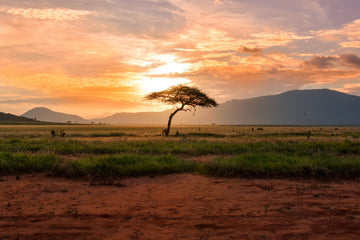Exploring the Terroir of Coffee: How the Place Where Coffee is Grown Can Influence Its Flavor
Have you ever wondered what contributes to the unique flavors and aromas of your favorite cup of coffee? In this post, we will delve into the concept of terroir and how various environmental factors, including soil composition, climate, topography, and biodiversity, contribute to the distinct characteristics of individual coffees. Join us as we explore the intricate interplay of nature and human influence that creates the diverse profiles that captivate our senses.
Components of Terroir
Terroir (/tɛˈrwɑːr/) is French for "land" or "soil" and represents a complex concept with multiple components. While often used in conversations about wine, it's applicable to coffee, and other artisanal crops, as well. At its core, terroir encompasses the specific soil composition, climate, and topography of a farm, which together influence the growth and expression of a crop.
- Temperature, altitude, rainfall, and humidity significantly influence coffee flavor and quality, with optimal conditions promoting slower development for more complexity
- Soil composition, including texture, mineral content, and pH, impacts coffee by influencing nutrient availability, water retention, and flavor compound development
- Topography, including elevation, slope, and aspect, shapes the microclimate and growing conditions, which in turn influence maturation and flavor development
Beyond these natural factors, terroir also acknowledges the human element, encompassing variety selection, cultivation practices, and traditions that have evolved over time in a given region. Collectively, these components create a sense of place, endowing coffees with a unique identity that reflects the essence of their origin.
Climate and its Effect on Coffee Flavor
Temperature plays a crucial role in the development of coffee by affecting the rate of photosynthesis and metabolism in the plants. Generally, higher temperatures lead to faster maturation, resulting in a simpler, less complex flavor profile, while lower temperatures promote slower bean development and more nuanced flavors. Altitude is another key factor, as higher elevations often exhibit cooler temperatures and greater diurnal temperature variations, contributing to a slower ripening process.
Rainfall impacts the timing and extent of flowering and fruit development. Insufficient or excessive rainfall can stress the plants, leading to inconsistent yield and bean quality. Humidity also affects coffee bean growth, with an optimal relative range of 60-70%. Humidity levels outside this range can lead to increased pest and disease pressure or improper drying of the beans, potentially diminishing the overall quality and flavor of the final product.
Soil Composition and its Influence on Coffee Taste
Soils with proper drainage, typically a blend of sand, silt, and clay particles, create an ideal environment for coffee plant root systems by allowing access to water and nutrients without becoming waterlogged. Such soils contribute to the overall health of the plants and promote robust growth and better resilience against pests and diseases.
Rich, fertile soils, balanced with organic matter and minerals like nitrogen, phosphorus, and potassium, promote healthy plant growth and maturation and influence the development of flavor compounds within the beans. Soil pH impacts the ability of the plants to absorb essential elements. Additionally, the presence of minerals like iron, manganese, or magnesium can contribute subtle yet discernible nuances.
Topography and its Impact on Coffee Cultivation
The topography of a coffee-growing site impact the taste of coffee by shaping the microclimate and growing conditions experienced by the plants.
Elevation plays a crucial role in determining temperature, with higher altitudes typically resulting in cooler temperatures and greater diurnal temperature variations. This encourages a slower bean maturation process, allowing for the development of more complex and nuanced flavors.
Slope and aspect, which determine the degree and direction of a terrain's inclination, influence factors such as sun exposure, wind patterns, and water drainage. Steeper slopes can facilitate better drainage, preventing waterlogged soil and root systems, while also providing increased sun exposure that can enhance the ripening process.
Biodiversity and its Effect on Coffee Terroir
Biodiversity, the variety of life within an ecosystem, plays a noteworthy role in shaping the taste of coffee by fostering a dynamic and balanced growing environment for coffee plants. The presence of diverse microscopic and macroscopic flora and fauna within and around coffee farms contributes to a healthy ecosystem, promoting natural pest control, pollination, and nutrient cycling.
Shade trees provide a habitat for a multitude of organisms and regulate the microclimate, reducing temperature fluctuations and protecting coffee plants from excessive sunlight. This results in a slower bean maturation process.
Further, the rich microscopic biodiversity in the soil helps break down organic matter, releasing essential nutrients that support coffee plant growth and development. Insect pollinators, like bees, can also enhance coffee quality and yield by facilitating cross-pollination, which can lead to increased genetic diversity and resilience in coffee plants.
Single Origin Coffee and the Terroir Experience
Since terroir is all about place, the best way to experience it is to try a single origin coffee. Single origin coffee is sourced from one single producer, crop, or region in one country. This selectivity allows you to enjoy the unique characteristics of the specific area where the coffee was grown.
Try comparing single origin coffees from different regions to discern their unique characteristics You can also experiment with different brewing methods to discover the best way to highlight each coffee's characteristics.
The journey through coffee terroir unveils the intricate relationships between natural elements, human influence, and the flavors and aromas that make each coffee unique. By understanding the role of soil composition, climate, topography, and biodiversity in coffee cultivation, we can not only appreciate the complex flavor profiles of single origin coffees but also develop greater respect for the diverse ecosystems that nurture them.



